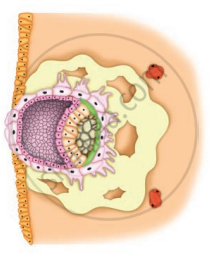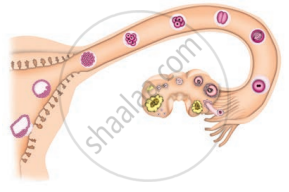Advertisements
Advertisements
Question
Draw a well labelled diagram of T.S. anther.
Solution

APPEARS IN
RELATED QUESTIONS
Define reproduction.
Which type of reproduction :
involves gametes?
Which type of reproduction :
does not involve gametes?
Name two animals which reproduce asexually.
What is a clone? Why do offsprings formed by asexual reproduction exhibit remarkable similarity?
Match the organisms given in column I with the methods of reproduction/propagation given in column II :
| Column I | Column II | |
| (i) Plasmodium | (a) Spore formation | |
| (ii) Spirogyra | (b) Leaves | |
| (iii) Jasmine | (c) Regeneration | |
| (iv) Apple tree | (d) Budding | |
| (v) Bryophyllum | (e) Binary fission | |
| (vi) Potatoes | (f) Layering | |
| (vii) Rhizopus | (g) Fragmentation | |
| (viii) Hydra | (h) Tubers | |
| (ix) Planaria | (i) Cuttings | |
| (x) Leishmania | (j) Multiple fission | |
| (xi) Sugar cane | (k) Grafting | |
| (xii) Rose |
What are the two general methods of reproduction in organisms?
Asexual reproduction is :
(a) a fusion of specialised cells
(b) a method by which all types of organisms reproduce
(c) a method producing genetically identical offspring
(d) a method in which more than one parent are involved
Name two animals which undergo internal fertilisation?
Fill in the following blank with suitable word :
The union of a sperm nucleus with an egg nucleus is known as.......... and results in a .........egg.
Imagine all the seeds produced by a plant happen to fall under the same plant and sprout into new plants. Mention any two problems that will be faced by the new plants.
State whether the following statement is true (T) or false (F):
Most organisms have the capacity of regeneration in some or the other way.
Why is reproduction necessary for living organisms?
Multiple choice question.
The ploidy level is not the same in ______.
What is hilum with respect to ovule?
What is the function of inner cell mass?
What are the causes for the extinction of animals?
Reproductive part of a plant is ______.
Observe the following figures.
 |
 |
 |
|
| (a) | (b) | (c) | (d) |
- Identify the stages (a) to (d) in figure during development of human baby.
- Arrange the stages in correct sequence of development.
- Explain the development that takes place in any one stage.
The statement ‘nothing lives forever, yet life continues’ illustrates the role of ______.

